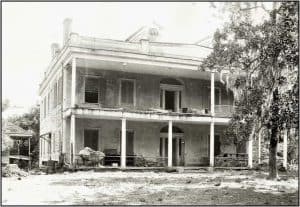Revisiting Goat Castle
Jennie Merrill was murdered in her Natchez home in a botched robbery in 1932. Karen Cox’s new book examines
the bizarre true story and why it matters to the South today.
BY ALEC HARVEY
A professor of history at the University of North Carolina at Charlotte, Karen Cox was researching another topic when she came across the story of Jennie Merrill, murdered in Natchez in 1932. The resulting work is Goat Castle: A True Story of Murder, Race, and the Gothic South. Cox answered five questions about the new book in advance of her appearance in Oxford at Square Books on Nov. 14.
When did you first become aware of the “Goat Castle” story?

I first became aware of the story when I was working in the state archives in Jackson. I was doing research for an earlier book in which I was seeking to understand more about Natchez and the founding of the pilgrimage. Specifically, I wanted to know why Americans from the Northeast, the Midwest and other parts of the country were traveling to Natchez in the middle of the Great Depression. What was it that made people risk life and limb on the roads of the time to see their grand houses?
Clinton Bagley, who is the historian and Natchez expert, said to me, “If you want to know about Natchez you should look at Goat Castle. Goat Castle put Natchez on the map.” I had him repeat himself. “Did you say Goat Castle?” He had.
That day I requested the vertical file of clippings on the case that became known as the “Goat Castle murder,” and I knew instinctively that this was a story that I wanted to work on as soon as I finished the last book. There was something there worth investigating. I thought that it was going to be this wacky story about these two individuals, Dick Dana and Octavia Dockery, and their live-in goats. It turned out that it was much more complex than that.
Can you tell me about Natchez in 1932 and how this all came about?
In 1932, Natchez, like the rest of the country, was in the midst of the economic depression. The Natchez Garden Club, however, created a tourist event in which these women invited the touring public to visit the grand antebellum homes of the town. That was in late March 1932. Many men in town thought it was ridiculous, but when the pilgrimage rolled around, it surprised everyone, because it drew visitors from 38 states. The pilgrimage motto was “Come to Natchez, Where the Old South Still Lives.” Then just a few months later, one of the remaining descendants of the planter aristocracy in Natchez was murdered. Jennie Merrill was killed in her home during a botched robbery, which shocked the town. In some sense, the Old South had, in the killing of Merrill, literally died in a town where garden club members proclaimed it still lived.
Was there a lot of existing information about the case, or was it a lot of history detective work, or both?
There was considerable coverage in both the Natchez Democrat and the New Orleans Times-Picayune, and the story was covered nationally in large and small newspapers, but even that was not enough. I did a significant amount of history detective work to get to the full story and not just what was in the papers.
I discovered Emily Burns’ signed confession in an archive, I interviewed people from the community, I did the genealogy of all of the principles, and my biggest find came while digging through Adams County Court ledgers that were being stored in what had been the freezer of an abandoned pie factory. There, I found the witness docket for Emily Burns’ trial.
Of course, I already knew who those individuals were from the newspaper, but what that docket gave me was the case number. It was that case number that led me to files kept at the Historic Natchez Foundation and where I discovered even more information about the trial that I used in the book. I love being a history detective, and they should really have me on that show of the same name on PBS. It’s like putting together a puzzle, because as the pieces come together a picture emerges. This is how it worked with “Goat Castle.”
Did you come across anything that surprised you?
I believe that the one item that I discovered that surprised me was Emily Burns’ signed confession. She was the only person tried for Jennie Merrill’s murder. And she was convicted and sent to Parchman, the Mississippi State Penitentiary.
Most of the actual evidence from the trial has long since been lost. It appears to have been taken to New Orleans by Maurice O’Neill, a detective called in to assist the Natchez sheriff with the case. A researcher went to New Orleans in the 1970s and “borrowed” some of that material and it ended up in the LSU Special Collections. One of those items was the signed confession, which was very revealing–not only about what happened on the night of the murder, but of how black women suspects were treated.
What do you hope people learn from this book?
I hope people will appreciate what history can teach us when we examine the lives of ordinary people in extraordinary circumstances. So often, truth is stranger than fiction and it couldn’t be truer than it is in this story. And while there is something comically dark about Goat Castle and its residents–the “Wild Man” and the “Goat Woman”–there is also a more poignant story of racial injustice. This book gives the reader all of that and then some.
Karen Cox will sign copies of Goat Castle on Nov. 14 at 5 p.m. at Square Books.







